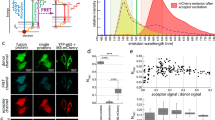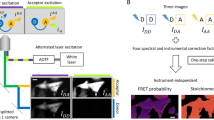Abstract
Studies of protein interactions have increased our understanding and knowledge of biological processes. Assays that utilize fluorescent proteins, such as fluorescence resonance energy transfer (FRET) and bimolecular fluorescence complementation (BiFC), have enabled direct visualization of protein interactions in living cells. However, these assays are primarily suitable for a pair of interacting proteins, and methods to visualize and identify multiple protein complexes in vivo are very limited. This protocol describes the recently developed BiFC–FRET assay, which allows visualization of ternary complexes in living cells. We discuss how to design the BiFC–FRET assay on the basis of the validation of BiFC and FRET assays and how to perform transfection experiments for acquisition of fluorescent images for net FRET calculation. We also provide three methods for normalization of the FRET efficiency. The assay employs a two-chromophore and three-filter FRET setup and is applicable to epifluorescence microscopes. The entire protocol takes about 2–3 weeks to complete.
This is a preview of subscription content, access via your institution
Access options
Subscribe to this journal
Receive 12 print issues and online access
$259.00 per year
only $21.58 per issue
Buy this article
- Purchase on Springer Link
- Instant access to full article PDF
Prices may be subject to local taxes which are calculated during checkout




Similar content being viewed by others
References
Hu, C.D., Chinenov, Y. & Kerppola, T.K. Visualization of interactions among bZIP and Rel family proteins in living cells using bimolecular fluorescence complementation. Mol. Cell 9, 789–798 (2002).
Shyu, Y.J., Liu, H., Deng, X. & Hu, C.D. Identification of new fluorescent protein fragments for bimolecular fluorescence complementation analysis under physiological conditions. Biotechniques 40, 61–66 (2006).
Periasamy, A. & Day, R.N. Visualizing protein interactions in living cells using digitized GFP imaging and FRET microscopy. Methods Cell Biol. 58, 293–314 (1999).
Piston, D.W. & Kremers, G.J. Fluorescent protein FRET: the good, the bad and the ugly. Trends Biochem. Sci. 32, 407–414 (2007).
Chen, H., Puhl, H.L., Koushik, S.V., Vogel, S.S. & Ikeda, S.R. Measurement of FRET efficiency and ratio of donor to acceptor concentration in living cells. Biophys. J. 91, L39–L41 (2006).
Pfleger, K.D., Seeber, R.M. & Eidne, K.A. Bioluminescence resonance energy transfer (BRET) for the real-time detection of protein–protein interactions. Nat. Protoc. 1, 337–345 (2006).
De, A., Loening, A.M. & Gambhir, S.S. An improved bioluminescence resonance energy transfer strategy for imaging intracellular events in single cells and living subjects. Cancer Res. 67, 7175–7183 (2007).
Gordon, G.W., Berry, G., Liang, X.H., Levine, B. & Herman, B. Quantitative fluorescence resonance energy transfer measurements using fluorescence microscopy. Biophys. J. 74, 2702–2713 (1998).
Xia, Z. & Liu, Y. Reliable and global measurement of fluorescence resonance energy transfer using fluorescence microscopes. Biophys. J. 81, 2395–2402 (2001).
Verveer, P.J., Rocks, O., Harpur, A.G. & Bastiaens, P.I.H. Measuring FRET by sensitized emission. Cold Spring Harb. Protoc. doi:10.1101/pdb.ip15 (2006).
Shyu, Y.J., Suarez, C.D. & Hu, C.D. Visualization of AP-1-NF-kappaB ternary complexes in living cells by using a BiFC-based FRET. Proc. Natl. Acad. Sci. USA 105, 151–156 (2007).
Adams, P.D., Seeholzer, S. & Ohh, M. Identification of associated proteins by coimmunoprecipitation. In Protein–Protein Interactions: A Molecular Cloning Manual (ed. Golemis, E.A.) 5.59–5.74 (Cold Spring Harbor Laboratory Press, Cold Spring Harbor, New York, 2002).
Ong, H.L. et al. Dynamic assembly of TRPC1-STIM1-Orai1 ternary complex is involved in store-operated calcium influx. Evidence for similarities in store–operated and calcium release-activated calcium channel components. J. Biol. Chem. 282, 9105–9116 (2007).
Canonici, A. et al. Insulin-like growth factor-I receptor, E-cadherin and alpha v integrin form a dynamic complex under the control of alpha-catenin. Int. J. Cancer 122, 572–582 (2008).
Galperin, E., Verkhusha, V.V. & Sorkin, A. Three-chromophore FRET microscopy to analyze multiprotein interactions in living cells. Nat. Methods 1, 209–217 (2004).
Kinoshita, K. et al. Ternary complex formation of pVHL, elongin B and elongin C visualized in living cells by a fluorescence resonance energy transfer-fluorescence lifetime imaging microscopy technique. FEBS J. 274, 5567–5575 (2007).
Rizzo, M.A., Springer, G.H., Granada, B. & Piston, D.W. An improved cyan fluorescent protein variant useful for FRET. Nat. Biotechnol. 22, 445–449 (2004).
Nagai, T. et al. A variant of yellow fluorescent protein with fast and efficient maturation for cell-biological applications. Nat. Biotechnol. 20, 87–90 (2002).
Chen, L. et al. Structure of the DNA-binding domains from NFAT, Fos and Jun bound specifically to DNA. Nature 392, 42–48 (1998).
Hogan, P.G., Chen, L., Nardone, J. & Rao, A. Transcriptional regulation by calcium, calcineurin, and NFAT. Genes Dev. 17, 2205–2232 (2003).
Kerppola, T.K. Design and implementation of bimolecular fluorescence complementation (BiFC) assays for the visualization of protein interactions in living cells. Nat. Protoc. 1, 1278–1286 (2006).
Verveer, P.J., Harpur, A.G. & Bastiaens, P.I.H. Imaging protein interactions by FRET micrsocopy. In Protein–Protein Interactions. A Molecular Cloning Manual (ed. Golemis, E.A.) 10 (Cold Spring Harbor Laboratory Press, Cold Spring Harbor, NewYork, 2002).
Ghosh, I., Hamilton, A.D. & Regan, L. Antiparallel lucine zipper-directed protein reassembly: applications to the green fluorescent protein. J. Amer. Chem. Soc. 122, 5658–5659 (2000).
Zhang, S., Ma, C. & Chalfie, M. Combinatorial marking of cells and organelles with reconstituted fluorescent proteins. Cell 119, 137–144 (2004).
Jach, G., Pesch, M., Richter, K., Frings, S. & Uhrig, J.F. An improved mRFP1 adds red to bimolecular fluorescence complementation. Nat. Methods 3, 597–600 (2006).
Fan, J.Y. et al. Split mCherry as a new red bimolecular fluorescence complementation system for visualizing protein–protein interactions in living cells. Biochem. Biophys. Res. Commun. 367, 47–53 (2008).
Bastiaens, P.I.H. & Jovin, T.M. Fluorescence resonance energy transfer microscopy. In Cell Biology. A Laboratory Handbook. Vol. 3 (ed. Celis, J.E.) 136–146 (Academic Press, New York, 1998).
Cardullo, R.A., Mungavon, R.M. & Wolf, D.E. Fluorescence resonance energy transfer microscopy: theory and instrumentation. Methods Cell Biol. 72, 415–430 (2003).
Sekar, R.B. & Periasamy, A. Fluorescence resonance energy transfer (FRET) microscopy imaging of live cell protein localizations. J Cell Biol. 160, 629–633 (2003).
Shaner, N.C., Steinbach, P.A. & Tsien, R.Y. A guide to choosing fluorescent proteins. Nat. Methods 2, 905–909 (2005).
Tsien, R.Y. The green fluorescent protein. Ann. Rev. Biochem. 67, 509–544 (1998).
Koushik, S.V., Chen, H., Thaler, C., Puhl, H.L. III & Vogel, S.S. Cerulean, venus, and venusY67C FRET reference standards. Biophys. J. 91, 99–101 (2006).
Hu, C.D. & Kerppola, T.K. Simultaneous visualization of multiple protein interactions in living cells using multicolor fluorescence complementation analysis. Nat. Biotechnol. 21, 539–545 (2003).
Hu, C.D., Grinberg, A. & Kerppola, T.K. Visualization of protein interactions in living cells using bimolecular fluorescence complementation. In Curr. Protoc. Cell Biol. (eds. Bonifacino, J.S., Dasso, M., Harford, J.B., Lippincott-Schwartz, J. and Yamada, K.M.) 21.3.1–21.3.21 (John Wiley & Sons, Hoboken, NJ, 2005).
Gallagher, S., Winston, S.E., Fuller, S.A. & Hurrell, G.R. Immunoblotting and immunodetection. In Curr. Protoc. Cell Biol. (eds. Bonifacino, J.S., Dasso, M., Harford, J.B., Lippincott-Schwartz, J. & Yamada, K.M.) 6.2.1–6.2.20 (John Wiley & Sons, New York, 1998).
Bearer, E.L. Overview of image analysis, image importing, and image processing using freeware. In Curr. Protoc. Mol. Biol. (eds. Ausubel, F.M. et al.) 14–15 (John Wiley & Sons, Hoboken, NJ, 2003).
Zal, T. & Gascoigne, N.R. Photobleaching-corrected FRET efficiency imaging of live cells. Biophys. J. 86, 3923–3939 (2004).
Damelin, M. & Silver, P. Analysis of protein interactions in vivo with fluorescence resonance energy transfer (FRET). Cold Spring Harb. Protoc. doi:10.1101/pdb.prot4581 (2006).
Damelin, M. & Silver, P. Experimental design for in vivo FRET analysis. Cold Spring Harb. Protoc. doi:10.1101/pdb.ip10 (2006).
Acknowledgements
We thank Drs. David Piston and Atsushi Miyawaki for kindly providing the cDNAs for Cerulean and Venus, as well as the Hu Laboratory members for their helpful discussions. C.D.H. was supported by grants from the Purdue Cancer Center (NCI-P30CA23168), the Indiana Elks Inc., Walther Cancer Institute, National Science Foundation (0420634-MCB) and the American Heart Association (0655570Z).
Author information
Authors and Affiliations
Corresponding author
Rights and permissions
About this article
Cite this article
Shyu, Y., Suarez, C. & Hu, CD. Visualization of ternary complexes in living cells by using a BiFC-based FRET assay. Nat Protoc 3, 1693–1702 (2008). https://doi.org/10.1038/nprot.2008.157
Published:
Issue Date:
DOI: https://doi.org/10.1038/nprot.2008.157
This article is cited by
-
Antibody-driven capture of synaptic vesicle proteins on the plasma membrane enables the analysis of their interactions with other synaptic proteins
Scientific Reports (2019)
-
Techniques for detecting protein-protein interactions in living cells: principles, limitations, and recent progress
Science China Life Sciences (2019)
-
Optimal fluorescent protein tags for quantifying protein oligomerization in living cells
Scientific Reports (2018)
-
Fluorescence resonance energy transfer microscopy as demonstrated by measuring the activation of the serine/threonine kinase Akt
Nature Protocols (2013)
-
Characterization of the latent membrane protein 1 signaling complex of Epstein-Barr virus in the membrane of mammalian cells with bimolecular fluorescence complementation
Virology Journal (2011)
Comments
By submitting a comment you agree to abide by our Terms and Community Guidelines. If you find something abusive or that does not comply with our terms or guidelines please flag it as inappropriate.



